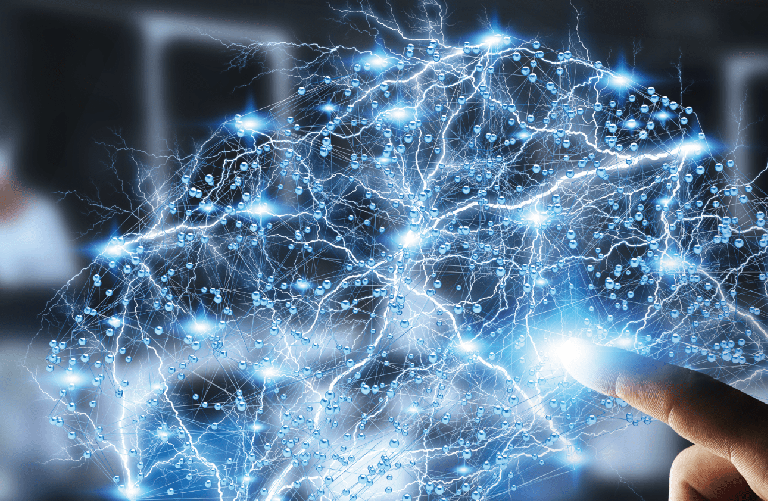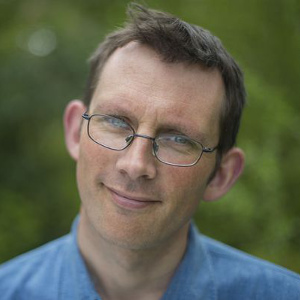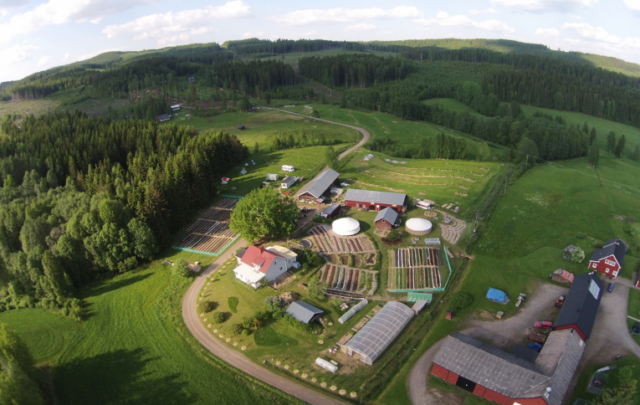What happens in the brain when we’re being imaginative? Neuroscientists are moving away from the idea of what’s called ‘localisationism’ (the idea that each capacity of the brain is linked to a particular ‘area’ of the brain) towards the idea that what’s more important is to identify the networks that fire in order to enable particular activities or insights. Alex Schlegel is a cognitive neuroscientist, which he describes as being about “trying to understand how the structure and function of the brain creates the mind and the consciousness we experience and everything that makes us human, like imagination”.
He recently co-published fascinating research entitled “Network structure and dynamics of the mental workspace” which appeared in Proceedings of the National Academy of Sciences, which identified what the authors called “the mental workspace”, the network that fires in the brain when we are being imaginative. I spoke to Alex via Skype, and started by asking him to explain what the mental workspace is [here is the podcast of our full conversation, an edited transcript appears below].
This is maybe just a product of the historical moment we’re in with cognitive neuroscience researching, that most of neuroscience research, I think I would say even now, is still focused on finding where is the neuro correlate of some function? Where does language happen? Where does vision happen? Where does memory happen? Those kinds of things.
It was very easy to ask those questions when fRMI came around, because we could stick someone in the scanner and have them do one task, and do a control test, and then do the real test, and see what part of the brain lights up, in one case rather than the other. Those very well controlled reductionist kinds of paradigms behind these very clean blobs where something happens in one case versus the other. I think that led a lot to the story of one place in the brain for every function and we just have to map out those places.
But in reality, the brain is a complex system. It works in a real world which is a complex environment, and in any kind of real behaviour that we engage in, the entire brain is going to be involved in one way or the other. Especially when you start to get into these more complex abilities that are very hard to reduce to this highly controlled A versus B kind of thing.

To really understand the behaviour itself, like imagination, it’s not that surprising that it’s going to be a complex, multi-network kind of phenomenon. I think why we were able to show that is maybe primarily because the techniques are advancing in the field and we’re starting to figure out how to look at these behaviours in a more realistic way. One of the big limitations of cognitive neuroscience research right now, because of fMRI, because of the techniques we’ve had, is that we tend of think of behaviour as activating, or not activating the brain.
When we’re doing analyses of brain activity, we’re looking for areas that become more active than another. This is changing a lot in the last few years, but at least for the first fifteen, twenty years, that was one of the only ways we would look at brain activity. So it simplistically thinks of the brain as of some other organ where it’s either buzzing, or it’s not buzzing, or it’s buzzing, or it’s not buzzing, or if it buzzes, the language happens. But really the brain is a complex computational system.
It’s doing complex computations and information processing and that’s not something you’re really going to see if you’re just looking for, in a large area, increased versus decreased activity. When we start to be able to look at the brain more in terms of the information that is processing, and where we can see information, how we can see communication between different areas, then you can start to look at things like imagination, or mental workspace, in a more complex light.

So how does that idea sit alongside the ideas firstly of the ‘Default Network’, which is often linked to creativity and imagination as well, and also to the idea that the hippocampus is the area that is essential to a healthy, functioning imagination? Do those three ideas just fit seamlessly together, or are they heading off in different directions?
I can give you my opinion, that’s not very well founded in any kind of data, but this is something that we’ve talked about a lot in the lab. I have a suspicion that actually we had been thinking about how to test for a while. So the Default Mode Network was first seen as this network that would become more active in between tasks. So when we’re doing an fRMI experiment what we’ll usually do is you’ll have some period where you’re doing the task, and then there’s a period where you’re just resting, so you can get the baseline brain activity when you’re not doing anything. And this was a surprising result, is that actually during rest periods, some areas of the brain become more active. And, you know, “Oh wow, it’s a surprise, the person’s not just sitting there blankly doing nothing.” The brain doesn’t just totally deactivate. They’re doing other stuff during those blank periods where there’s no stimulus on the screen.
From my personal experience, what you do in those rest periods is you daydream. Your mind wanders. You think about what you’re going to do afterwards, or stuff that’s happened during the day. There’s a lot of research since then to back that up. It seems to be this kind of network that’s highly involved in daydreaming like behaviour, or social imagination, those kinds of things.
My opinion, or my suspicion, is that this is illustrating how our term ‘imagination’ really encompasses a lot of different things. When you try to lump it under this one term, this one mega term, you’re going to be missing out on a lot of the complexity, or subtlety. So what I suspect is going on is that there’s this more like daydreaming mode of control over your inner space, where you’re not really consciously, volitionally, directing yourself to have certain experiences. There’s a default control network that’s more taking over the daydreaming.
When I daydream I’m not trying to think about anything, it’s just letting the thoughts come. That’s maybe part of what imagination is, but a very important part of imagination is you trying to imagine things, trying to direct yourself, thinking, “Well, what is the relationship between these two things? Or “how can I build community?”” Or something like that. In that case you’re taking active volitional control over these systems. So that would be my suspicion of what’s going on.
How the results we found would differ from default mode network is that in our study we would show people some stimulus (see below) and we would say, “Rotate this 90 degrees clockwise”, so they had this fairly difficult task that they had to do and it was effortful. This more frontal parietal network probably took over then. And you see that a lot in other studies. Our frontal parietal, I think they sometimes call it like an Executive Attention Network, that directs when you’re consciously trying to engage in some tests, that takes over, and if you’re not doing anything, the default mode network takes over.

So they’re both different manifestations of the imagination? Like an active and a more passive, less conscious version? They’re two versions of the same thing, in a sense?
Yeah, I would think that. It fits well with what I’ve seen. There have been studies that show that they’re in some ways antagonistic or mutually inhibiting, the default mode network and this executive attention network…
It’s like oil or water, it’s one or the other? Or Ying and Yang, as I’ve read in some papers?
Right, but a simple way of describing these that people often resort to is that the Executive Attention Network is designed for attention to the outside world, and the Default Mode Network is attention to the inner space. Where I would disagree with that, or suggest that that’s not the case, is that I think a better way to classify it would be that executive attention is more of this volitionally driven attention, which is usually associated with attention to the outside world. And default mode network is more – I don’t know how to describe it exactly, but it’s more of this daydreaming network. But the point is that your executive volitional attention can be driven to the inner space just as much as it can be driven to the outside world.
Is the mental space network the same kind of network that would be firing in people as when they’re thinking about the future and trying to be imaginative about how the future could be?
Yeah, I would think so. I think an important difference, or an important additional part that you might start to see if you’re thinking about imagining the future, is that practically most of the time when you’re imagining the future, you’re thinking about people, and social groups, and how to navigate those kinds of dynamics.
So I would guess that then you would get added into the mix all the social processing networks that we have. That’s actually another thing that we’re thinking about how to look at, is that practically a big chunk of human cognition is spent thinking about your relationship with other people, and how to navigate that. There’s a good argument to be made that that kind of complex processing space was one of the main drivers of us becoming who we are. Because social cognition is some of the most complex cognition we do, trying to imagine what somebody’s thinking by looking at their facial expression, or imagine how do I resolve a conflict between these two people who are fighting. Things like that.
We do have very specialised regions and networks in the brain that have evolved to do that kind of processing. So yeah, it’s a very interesting question. That how would these other mental workspace areas, at least that we looked at, that had nothing to do with it, you know, it’s like, “Here’s this abstract shape. What does it look like if you flip it horizontally here”, things like that. How would they interact with these socially evolved areas? It’s a very interesting question.
A lot of the research that I’ve been looking at is about how when people are in states of trauma, or when people grow up in states of fear, that the hippocampus visibly shrinks and that cells are burnt out in the hippocampus, and that people become less able to imagine the future. People get stuck in the present, and it’s one of the indicators, particularly with post-traumatic stress, is that inability to look forward, and inability to imagine a future. Do you have any knowledge of, or any speculation about, what happens to the mental workspace when people are in states of trauma or when people are in states of fear?
Definitely no data, only speculation. As with anything real and interesting involving humans, it’s going to be incredibly complex. So it would be very difficult, and may be impossible to distil it down to simple understandable things that are happening in the brain, but what I would guess is that, in people that are in stressful situations, and experiencing trauma, you tend to focus – like you were hinting at – you tend to focus on present. What’s there immediately? How do I survive this day?
You don’t tend to think much about planning for the future. Synthesising everything that’s happened to you in the past, you just react in the moment because you don’t know what the next moments are going to be like. It’s no more cognitive load that you can deal with because of all the stress you have. So I would guess that for one you’re not really synthesising or processing your experiences into something brought to bear on decisions in the future as much.
And you’re not exercising those muscles of planning far into the future. So just like any other muscle in the body, if you don’t practice the skills, and you don’t use various parts of your brain, they’re going to atrophy. They’re not going to develop in the way that they would if you did use them. In that sense it seems perfectly understandable and not that surprising that these areas and these networks that we found associated with these kinds of activities of projecting oneself in the future, or imaging that things don’t exist, in people for whatever reason aren’t doing that kind of thing regularly in their lives, they’re not going to be developed as much as they would from people that were happy and healthy and imaginative.
The paper that Kyung Hee Kim published in 2010, ‘The Creativity Crisis’ suggested that we might be seeing a decline in our collective imagination. Do you have any thoughts on why that might be, or what might be some of the processes at work here?
I could speculate a couple of things. The first thing that pops to mind obviously is education. How we think about the educational system, how we train children. And I don’t know about 1990 in particular but definitely starting in 1999 when we became test-crazed, that would be a very obvious culprit.
One thing to think about with the Torrance test and pretty much all tests, these standardised tests of creativity that we use, is that one of the major components that determines the outcome on the test is this divergent thinking idea. How many ideas can you come up with? So this has, I think, fairly detrimentally become one of the working definitions we have in psychology research of creativity, is “how much?” And not really focusing on quality so much, and just using how many ideas you can think of as a stand in for how creative someone is.
The Torrance Test is better because it does get into other dimensions as well, but still some of the major dimensions determining the score are fluency, when you’re doing these drawings, how many components are there in the drawing? That kind of thing. So for instance if there were educational trends starting in the 1990s and continuing to now that were leading people to try to converge rather than diverge – you know, “What’s the one right answer?” versus, “What are lots of possible answers?” – then that could definitely lead to these changes we’ve been seeing in the tests.
Even if that were the case though, is that really a problem? Obviously we want people to be able to think of lots of possibilities but if it’s just, for instance, people who have been brought up in an educational system where they’ve been taking standardised tests all the time, and they’re trying to figure out which of the four bubbles is the right one to fill in, then that could just be a habit they’ve developed that carries over to these tests. I don’t know exactly.

Another idea that maybe would be related to this is we’re definitely much less idle than we were in the past. I guess we lament all the time how overscheduled kids are. They go from soccer practice to band practice to art class, to blah, blah, blah, blah, trying to fill up their resume for college or whatever. So if somebody is just constantly buzzing, busy, not really just stopping and daydreaming, and throwing rocks in creeks or whatever, then that’s again, it’s a habit they’re not going to have developed and they’re not going to be able to use as well.
This idleness, or giving up control to the Default Mode Network maybe, if you will, letting those ideas come in, exploring possibilities, those are things that I think often come out of boredom. And if you’re never bored, you’re never really letting those processes happen. So that would be another thing to think about.
So if somebody is less imaginative, is that because that when the mental workspace fires, it’s including less places, or that it’s joining them up less vigorously? I don’t have all the terminology. It all fires, but it fires to less places? Or it fires less strongly to all those different places?
I think it would be basically everything, to give you a terrible answer. For instance, this is where we’re really getting at how imagination is a very, very complex process that we’re distilling to a single word, and it’s really thousands of parts to come together.
For instance, if you can imagine visual experiences more or less vividly, then that’s going to play a role. Somebody who can have very vivid mental images of things is going to probably have an easier time recombining things than somebody who really struggles to form a visual image. Or on the flip side, there’s a lot of circumstantial evidence that people tend to go to one end or another of being very visual people, and I consider myself on those… When I think, I tend to think a lot in terms of visual representations. So it’s very easy for me to do the kinds of tasks that I ask subjects to do, where you know, “Here’s this weird random shape, what would it look like if it was rotated 90 degrees?”
Some people have a really hard time doing that kind of stuff though. They’ve very smart people, but they’re just terrible at mentally manipulating images. But if you have them think about other things, like more verbal kinds of verbal logical representations, they’re really good at that. So even trying to talk about the mental workspace network as one static network of areas in the brain is probably not true, or probably not accurate because different people will have different connections, or different parts of it will be more active than others.
When I’m trying to mentally imagine things, for some people like me, that might involve mental or visual images, and that’s the way I think about it, but for other people it might involve much more the language areas of the brain, exercising that language network in a more mental way. And that might lead to strengths for some people versus others, and vice versa, depending on what kinds of tests you’re trying to do, or whether you’re a verbal person that’s being forced to try to do something visual, or vice versa.
So given that these networks are involved are these complex information processing systems, there’s any number of ways where they can differ or fail, or become strengthened or become atrophied.
One of the questions I’ve asked everybody that I’ve interviewed has been if you had been elected last year as the President on a platform of ‘Make America Imaginative Again’, if you had thought actually one of the most important things we need is to have young people have a society that really cherishes the imagination, an education system where people come out really fired up and passionate, what might be some of the things you would do in your first 100 days in office?
First 100 days? Well I think the real solutions are things that are more like 20 year solutions. So you can start at a 100 days I guess but you definitely won’t solve it in 100 days. For me it all comes down to how we choose to educate people. I come at this all from a perspective of the US education system, so one thing is that we don’t view a teacher as a profession really, in the same way that we do as a medical doctor, or a lawyer.
I would say we need the equivalent training and residencies and professional degrees for teachers that we would have with anything else that’s as important a profession as teaching is. Obviously we shouldn’t be focused on tests in the way that we are. If you teach tests, and you teach to the kind of competencies a child should achieve by fifth grade, you’re going to be ignoring all the things that are hard to measure, for one thing, like imagination, creativity, curiosity. How do you evaluate whether a kid’s curious? I don’t know.
One of the changes I would want to see is that we trust more that the outcomes that we want will come rather than need to see them happen, because if you need to see a result, then you’ll only focus the things that you can see. And for a lot of what education really does, it’s very hard to measure it in any reliable way. If your goal is create a society of people that are civically engaged, that are curious, that are creative, compassionate, that’s all stuff that you just have to set up a system to do that, and hope that the outcome you measure will be the society you create, basically. So that it frees you to focus on those things, and not focus on maths skills, reading skills, that kind of thing.
So in the first 100 days, what do you do? I don’t know. One concrete thing you could do is try to reorganise the teacher training system to make it more professionally aligned.
Like they have in Finland, where teachers are basically trained to Masters level, and then there’s no testing in schools of teachers. They are then just empowered to teach, and they have the most amount of play and the shortest school hours of any country in Europe, and they constantly gain the best results and the brightest students.
Maybe that would be the first thing we could do, just copy Scandinavia.






